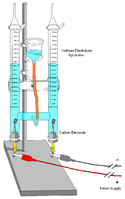
Photo from wikipedia
Abstract The extraction of energy from wastewater organic matter by microbial electrolysis cells (MEC) is a promising idea. However, different challenges have to be overcome before this technology can be… Click to show full abstract
Abstract The extraction of energy from wastewater organic matter by microbial electrolysis cells (MEC) is a promising idea. However, different challenges have to be overcome before this technology can be used in a practical application. One of the most important is the development of reactor configurations that can be able to produce higher external current and, thereby, a larger amount of energy carriers without significant deterioration of cell performance. Thus, a comprehensive 3D model, developed in this work, aims to investigate distributions of current, potential, and concentrations inside a MEC reactor and their effect on overpotential distribution over the surface of electrodes to evaluate the reactor performance. The model is applied to simulate a flow reactor designed with 147.6 m2 m−3 geometric surface area of the anode per unit volume. The results show the combined effect of flow pattern and electric field on the reactor behavior and performance. The model results of integrated current density over electrode surfaces closely describe experimental data of external current and hydrogen generation vs. time in feeding cycles. Experimental averages of maximum hydrogen production rate and electric current reached in each feeding cycle were 0.107 m3 m−3 h-1 and 0.29 A, respectively.
Journal Title: Biochemical Engineering Journal
Year Published: 2020
Link to full text (if available)
Share on Social Media: Sign Up to like & get
recommendations!